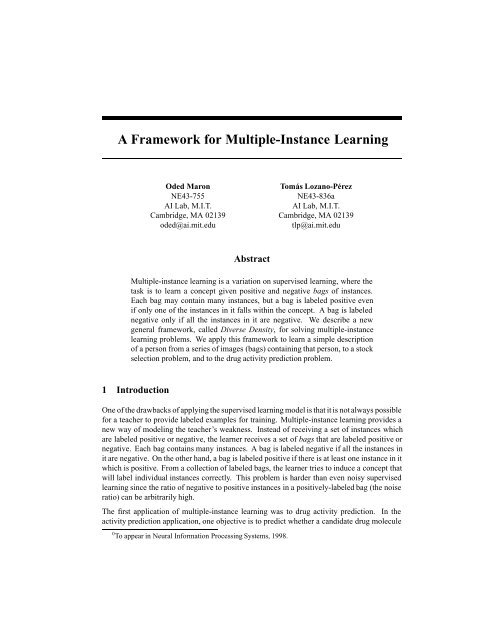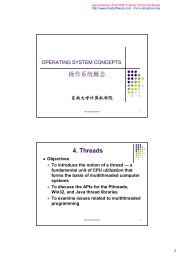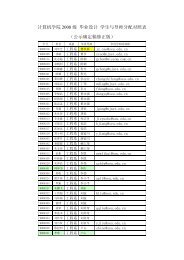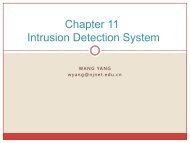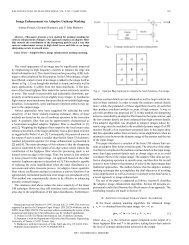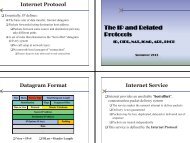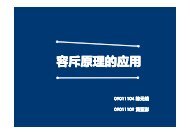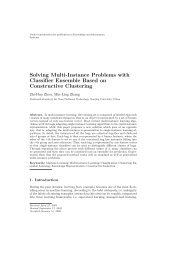A Framework for Multiple-Instance Learning
A Framework for Multiple-Instance Learning
A Framework for Multiple-Instance Learning
- No tags were found...
Create successful ePaper yourself
Turn your PDF publications into a flip-book with our unique Google optimized e-Paper software.
will bind strongly to a target protein known to be involved in some disease state. Typically,one has examples of molecules that bind well to the target protein and also of molecules thatdo not bind well. Much as in a lock and key, shape is the most important factor in determiningwhether a drug molecule and the target protein will bind. However, drug molecules areflexible, so they can adopt a wide range of shapes. A positive example does not convey whatshape the molecule took in order to bind – only that one of the shapes that the molecule cantake was the right one. However, a negative example means that none of the shapes that themolecule can achieve was the right key.The multiple-instance learning model was only recently <strong>for</strong>malized by [Dietterich et al., 1997].They assume a hypothesis class of axis-parallel rectangles, and develop algorithms <strong>for</strong> dealingwith the drug activity prediction problem described above. This work was followed by [Longand Tan, 1996], where a high-degree polynomial PAC bound was given <strong>for</strong> the number ofexamples needed to learn in the multiple-instance learning model. [Auer, 1997] gives a moreefficient algorithm, and [Blum and Kalai, 1998] shows that learning from multiple-instanceexamples is reducible to PAC-learning with two sided noise and to the Statistical Query model.Un<strong>for</strong>tunately, the last three papers make the restrictive assumption that all instances from allbags are generated independently.In this paper, we describe a framework called Diverse Density <strong>for</strong> solving multiple-instanceproblems. Diverse Density is a measure of the intersection of the positive bags minus the unionof the negative bags. By maximizing Diverse Density we can find the point of intersection(the desired concept), and also the set of feature weights that lead to the best intersection.We show results of applying this algorithm to a difficult synthetic training set as well as the“musk” data set from [Dietterich et al., 1997]. We then use Diverse Density in two novelapplications: one is to learn a simple description of a person from a series of images that arelabeled positive if the person is somewhere in the image and negative otherwise. The other isto deal with a high amount of noise in a stock selection problem.2 Diverse DensityWe motivate the idea of Diverse Density through a molecular example. Suppose that theshape of a candidate molecule can be adequately described by a feature vector . One instanceof the molecule is there<strong>for</strong>e represented as a point in n-dimensional feature space. As themolecule changes its shape (through both rigid and non-rigid trans<strong>for</strong>mations), it will trace outa manifold through this n-dimensional space 1 . Figure 1(a) shows the paths of four moleculesthrough a 2-dimensional feature space.If a candidate molecule is labeled positive, we know that in at least one place along themanifold, it took on the right shape <strong>for</strong> it to fit into the target protein. If the molecule is labelednegative, we know that none of the con<strong>for</strong>mations along its manifold will allow binding withthe target protein. If we assume that there is only one shape that will bind to the target protein,what do the positive and negative manifolds tell us about the location of the correct shapein feature space? The answer: it is where all positive feature-manifolds intersect withoutintersecting any negative feature-manifolds. For example, in Figure 1(a) it is point A.Un<strong>for</strong>tunately, a multiple-instance bag does not give us complete distribution in<strong>for</strong>mation,but only some arbitrary sample from that distribution. In fact, in applications other thandrug discovery, there is not even a notion of an underlying continuous manifold. There<strong>for</strong>e,1 In practice, one needs to restrict consideration to shapes of the molecule that have sufficiently lowpotential energy. But, we ignore this restriction in this simple illustration.
positivebag #1negative bagpositivebag #1negative bagpositivebag #2point Apositivebag #2point AsectionB {positivebag #3(a)The different shapes that a molecule cantake on are represented as a path. The intersectionpoint of positive paths is where theytook on the same shape.positivebag #3(b)Samples taken along the paths. Section Bis a high density area, but point A is a highDiverse Density area.Figure 1: A motivating example <strong>for</strong> Diverse DensityFigure 1(a) becomes Figure 1(b). The problem of trying to find an intersection changesto a problem of trying to find an area where there is both high density of positive pointsand low density of negative points. The difficulty with using regular density is illustrated inFigure 1(b), Section B. We are not just looking <strong>for</strong> high density, but high “Diverse Density”.We define Diverse Density at a point to be a measure of how many different positive bags haveinstances near that point, and how far the negative instances are from that point.2.1 Algorithms <strong>for</strong> multiple-instance learningIn this section, we derive a probabilistic measure of Diverse Density, and test it on a difficultartificial data set. We denote positive bags as B + i , the jth point in that bag as B + ij, and thevalue of the k th feature of that point as B + ijk . Likewise, B; ijrepresents a negative point.Assuming <strong>for</strong> now that the true concept is a single point t, we can find it by maximizingPr(x = t j B + 1 B+ n B; 1 B; m ) over all points x in feature space. If we use Bayes’rule and an unin<strong>for</strong>mative prior over the concept location, this is equivalent to maximizingthe likelihood Pr(B + 1 B+ n B; 1 B; m j x = t). By making the additional assumptionthat the bags are conditionally independent given the target concept t, the best hypothesis isarg max xQi Q Pr(B+ i j x = t) i Pr(B; i j x = t). Using Bayes’ rule once more (and againassuming a uni<strong>for</strong>m prior over concept location), this is equivalent toYarg max Pr(x = t j B + Yxi ) Pr(x = t j B ; i ): (1)iThis is a general definition of maximum Diverse Density, but we need to define the terms in theproducts to instantiate it. One possibilityis a noisy-or model: the probability that not all pointsmissed the target is Pr(x = t j B + i )=Pr(x = t j B+ i1 B+ :::)=1;Q i2 j (1;Pr(x = tjB+ ij )),and likewise Pr(x = t j B ; )=Q i j (1 ; Pr(x = t j B; ij )). We model the causal probability ofan individual instance on a potential target as related to the distance between them. Namely,Pr(x = t j B ij )=exp(; kB ij ; x k 2 ). Intuitively, if one of the instances in a positive bagis close to x, then Pr(x = t j B + i ) is high. Likewise, if every positive bag has an instanceclose to x and no negative bags are close to x, then x will have high Diverse Density. DiverseDensity at an intersection of n bags is exponentially higher than it is at an intersection of n ; 1bags, yet all it takes is one well placed negative instance to drive the Diverse Density down.i
(a) Surface using regular density(b) Surface using Diverse DensityFigure 3: Density surfaces over the example data of Figure 3major peaks in Figure 3(b) are the result of a chance concentration of instances from differentbags. With a bit more bad luck, one of those peaks could have eclipsed the one in the middle.However, the chance of this decreases as the number of bags (training examples) increases.One remaining issue is how to find the maximum Diverse Density. In general, we are searchingan arbitrary density landscape and the number of local maxima and size of the search spacecould prohibit any efficient exploration. In this paper, we use gradient ascent with multiplestarting points. This has worked succesfully in every test case because we know what startingpoints to use. The maximum Diverse Density peak is made of contributions from some setof positive points. If we start an ascent from every positive point, one of them is likely tobe closest to the maximum, contribute the most to it and have a climb directly to it. Whilethis heuristic is sensible <strong>for</strong> maximizing with respect to location, maximizing with respect toscaling of feature weights may still lead to local maxima.3 Applications of Diverse DensityBy way of benchmarking, we tested the Diverse Density approach on the “musk” data setsfrom [Dietterich et al., 1997], which were also used in [Auer, 1997]. We also have beguninvestigating two new applications of multiple-instance learning. We describe preliminaryresults on all of these below. The musk data sets contain feature vectors describing the surfacesof a variety of low-energy shapes from approximately 100 molecules. Each feature vectorhas 166 dimensions. Approximately half of these molecules are known to smell “musky,” theremainder are very similar molecules that do not smell musky. There are two musk data sets;the Musk-1 data set is smaller, both in having fewer molecules and many fewer instances permolecule. Many (72) of the molecules are shared between the two data sets, but the secondset includes more instances <strong>for</strong> the shared molecules.We approached the problem as follows: <strong>for</strong> each run, we held out a randomly selected1=10 of the data set as a test set. We computed the maximum Diverse Density on thetraining set by multiple gradient ascents, starting at each positive instance. This produces a
maximum feature point as well as the best feature weights corresponding to that point. Wenote that typically less than half of the 166 features receive non-zero weighting. We thencomputed a distance threshold that optimized classification per<strong>for</strong>mance under leave-one-outcross validation within the training set. We used the feature weights and distance threshold toclassify the examples of the test set; an example was deemed positive if the weighted distancefrom the maximum density point to any of its instances was below the threshold.The table below lists the average accuracy of twenty runs, compared with the per<strong>for</strong>manceof the two principal algorithms reported in [Dietterich et al., 1997] (iterated-discrimAPR and GFS elim-kde APR), as well as the MULTINST algorithm from [Auer, 1997].We note that the per<strong>for</strong>mances reported <strong>for</strong> iterated-discrim APR involves choosingparameters to maximize test set per<strong>for</strong>mance and so probably represents an upper bound <strong>for</strong>accuracy on this data set. The MULTINST algorithm assumes that all instances from allbags are generated independently. The Diverse Density results, which required no tuning, arecomparable or better than those of GFS elim-kde APR and MULTINST.Musk Data Set 1algorithmaccuracyiterated-discrim APR 92.4GFS elim-kde APR 91.3Diverse Density 88.9MULTINST 76.7Musk Data Set 2algorithmaccuracyiterated-discrim APR 89.2MULTINST 84.0Diverse Density 82.5GFS elim-kde APR 80.4We also investigated two new applications of multiple-instance learning. The first of these isto learn a simple description of a person from a series of images that are labeled positive ifthey contain the person and negative otherwise. For a positively labeled image we only knowthat the person is somewhere in it, but we do not know where. We sample 54 subimages ofvarying centers and sizes and declare them to be instances in one positive bag since one ofthem contains the person. This is repeated <strong>for</strong> every positive and negative image.We use a very simple representation <strong>for</strong> the instances. Each subimage is divided intothree partswhich roughly correspond to where the head, torso and legs of the person would be. The threedominant colors (one <strong>for</strong> each subsection) are used to represent the image. Figure 4 showsa training set where every bag included two people, yet the algorithm learned a descriptionof the person who appears in all the images. This technique is expanded in [Maron andLakshmiRatan, 1998] to learn descriptions of natural images and use the learned concept toretrieve similar images from a large image database.Another new application uses Diverse Density in the stock selection problem. Every month,there are stocks that per<strong>for</strong>m well <strong>for</strong> fundamental reasons and stocks that per<strong>for</strong>m well becauseof flukes; there are many more of the latter, but we are interested in the <strong>for</strong>mer. For everymonth, we take the 100 stocks with the highest return and put them in a positive bag, hopingthat at least one of them did well <strong>for</strong> fundamental reasons. Negative bags are created fromthe bottom 5 stocks in every month. A stock instance is described by 17 features such asmomentum, price to fair-value, etc. Grantham, Mayo, Van Otterloo & Co. kindly providedus with data on the 600 largest US stocks since 1978. We tested the algorithm through fiveruns of training <strong>for</strong> ten years, then testing on the next year. In each run, the algorithm returnedthe stock description (location in feature space and a scaling of the features) that maximizedDiverse Density. The test stocks were then ranked and decilized by distance (in weightedfeature space) to the max-DD point. Figure 5 shows the average return of every decile. Thereturn in the top decile (stocks that are most like the “fundamental stock”) is positive and
eturn0.21 2 3 4 5 6 7 8 9 10decile-0.2Figure 5: A training set of images with oneperson in common.-0.4Figure 6: Black bars show Diverse Density’saverage return on a decile, and thewhite bars show GMO’s predictor’s return.higher than the average return of a GMO predictor. Likewise, the return in the bottom decileis negative and below that of a GMO predictor.4 ConclusionIn this paper, we have shown that Diverse Density is a general tool with which to learn from<strong>Multiple</strong>-<strong>Instance</strong> examples. In addition, we have shown that <strong>Multiple</strong>-<strong>Instance</strong> problemsoccur in a wide variety of domains. We attempted to show the various ways in whichambiguity can lead to the <strong>Multiple</strong>-<strong>Instance</strong> framework: through lack of knowledge in thedrug discovery example, through ambiguity of representation in the vision example, andthrough a high degree of noise in the stock example.AcknowledgementsWe thank Peter Dayan and Paul Viola at MIT and Tom Hancock and Chris Darnell at GMO<strong>for</strong> helpful discussions and the AFOSR ASSERT program, Parent Grant#:F49620-93-1-0263<strong>for</strong> their support of this research.References[Auer, 1997] P. Auer. On <strong>Learning</strong> from Multi-<strong>Instance</strong> Examples: Empirical Evaluation of atheoretical Approach. NeuroCOLT Technical Report Series, NC-TR-97-025, March 1997.[Blum and Kalai, 1998] A. Blum and A. Kalai. A Note on <strong>Learning</strong> from <strong>Multiple</strong>-<strong>Instance</strong>Examples. To appear in Machine <strong>Learning</strong>, 1998.[Dietterich et al., 1997] T. G. Dietterich, R. H. Lathrop, and T. Lozano-Pérez. Solving the<strong>Multiple</strong>-<strong>Instance</strong> Problem with Axis-Parallel Rectangles. Artificial Intelligence Journal,89, 1997.[Long and Tan, 1996] P. M. Long and L. Tan. PAC-learning axis alligned rectangles withrespect to product distributions from multiple-instance examples. In Proceedings of the1996 Conference on Computational <strong>Learning</strong> Theory, 1996.[Maron and LakshmiRatan, 1998] O. Maron and A. LakshmiRatan. <strong>Multiple</strong>-<strong>Instance</strong> <strong>Learning</strong><strong>for</strong> Natural Scene Classification. In Submitted to CVPR-98, 1998.


